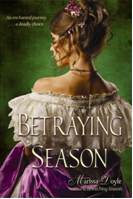
Christmas As We Know It: An Historical View
by Marissa Doyle
Ah, Christmas. Putting aside thoughts of the impossibility of finding a parking place at the mall or a present that your teenage niece will at least pretend to like, what comes to mind when you think of Christmas?
Twinkling trees and wreaths on doors…mouth watering cooking aromas…carols and family get-togethers and general good cheer…aren’t those what make up Christmas? Isn’t that the way it’s always been?
Well, actually, not really. In many ways, Christmas is a 19th century invention, an accidental by-product of politics…specifically, the fact that an 18-year-old girl became Queen of England back in 1837.
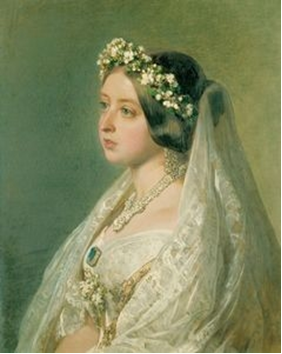
When young Victoria ascended the throne, she was an absolute sensation. England had been ruled by a line of rather skanky old men for the last hundred years or so, some of whom were German and had never even learned how to speak English, or were too preoccupied with their mistresses and shopping to pay much attention to ruling, or were locked away because of insanity (that was Victoria’s grandfather, George III). So when a pretty, virtuously wholesome, and very English girl became queen, the country went wild.
Bear with me here. I really am going to start talking about Christmas shortly.
Everyone was in love with Victoria. If a magazine editor wanted to sell out an issue, he included a story or picture of the Queen. If a manufacturer wanted to sell something—from tea to bonnets to carriages—he called it “the Victoria blend” or “the Victoria bonnet” or whatever, and it sold like hotcakes.
Everyone wanted to somehow reach out to her, share in her mystique, be like her, much in the same way that people in the seventies got Dorothy Hamill haircuts.
Which, on the whole, wasn't a bad thing—not the haircuts, that is, but trying to be like Victoria. Victoria actually had a conscience and believed in virtue and upholding public morals, and had arrived on the scene when there was a general shift in societal mores from the rather free-wheeling, heavy partying 18th and early 19th centuries to a more responsible, socially conscious world view. She was a harbinger of her times, and everyone ate it up.
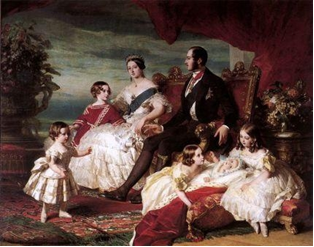
So of course the country was delighted when Victoria married in 1840, even if they didn’t think much of the minor German princeling she chose, Albert of Saxe-Coburg-Gotha. But they loved the fact that she was so in love with her new hubby, and were even happier when she started producing a family almost at once (her first child was conceived on her honeymoon!) “Family values” was the watchword here…and again, where Victoria led, the country followed.
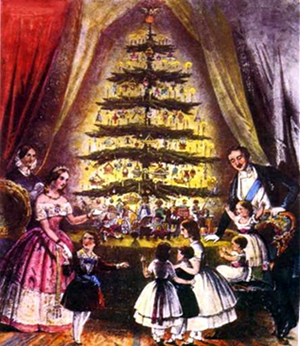
Now, here’s where Christmas comes in. Part of Victoria and Albert’s family values was celebrating Christmas and turning it into a family-centric holiday.
Though Christmas trees were not entirely new in England (the German wife of one of Victoria’s uncles had introduced them at court, and Victoria had them as a child thanks to her own German mother), Victoria and Albert’s trees became widely imitated by the Victoria-mad population of England, as well as their emphasis on making the holiday a joyous one for their children.
Suddenly everyone had to have a Christmas tree covered in lights and tinsel and little toys and candy for the kiddies. That’s what the Queen was doing, and the Queen was always right.
Other societal events built on this expanding Christmas trend—the wider availability of consumer goods produced by the rapidly industrializing country (i.e., more stuff to give each other as Christmas presents), and improvement in transportation (making it easier for far-flung family members to be together for the holidays), to name a couple.
After a while, it took on a life of its own, and more and more “traditions” in keeping with this new holiday spirit appeared.
The first Christmas cards were invented around this time, and the institution of the penny post guaranteed their success. The new focus on children helped the growth of the Father Christmas/Santa Claus tradition. And several very popular Christmas carols date from this time, including “O Come All Ye Faithful” (written in 1843), “O Little Town of Bethlehem” (1868) and “Away in a Manger” (1883).

Older Christmas customs still persisted—the Christmas pudding with its silver sixpence and thimble baked in (promising good luck for the year to whomever found it in their helping) and Wassail punch (which did indeed pack a punch!) But the traditional Christmas goose was just as likely to be a turkey as the years progressed (and as likely boiled as it was roasted), and mincemeat pies evolved from a savory main course dish containing minced beef or lamb and suet into the dessert we now know.
The Victorians truly raised this holiday to a high art, so that the words “Victorian Christmas” will indeed call to mind all those images you first thought about at the beginning of this article.
Return to the Literary Women page
Marissa Doyle is an unashamed history geek and author of two young adult novels set in early Victorian England, Bewitching Season (2008) and Betraying Season (2009)-with a third novel on the way—all from Henry Holt/Macmillan.
She spends summers, Thanksgiving and New Years in Chatham, but hasn’t tried Christmas there yet.
For more history geekiness, a.k.a. a look at 19th century history for teens, visit her
blog or her website
 |
 |
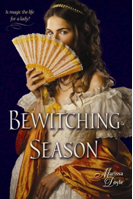
"Doyle offers a heart-throbbing romance full of magic and royal-court intrigue... Fans of historical mysteries will find this a page-turner." - -Kirkus
"Whether Doyle is describing the Irish countryside, a magical incantation, or a lover’s kiss, her writing is compelling, and it will be hard for readers not to be swept away…" - - Booklist
These books are available now from your local independent bookseller, Barnes & Noble or Amazon.
